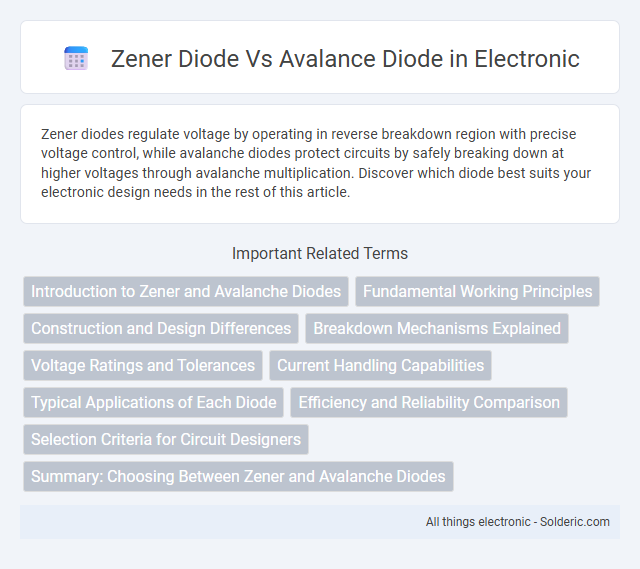Zener diodes regulate voltage by operating in reverse breakdown region with precise voltage control, while avalanche diodes protect circuits by safely breaking down at higher voltages through avalanche multiplication. Discover which diode best suits your electronic design needs in the rest of this article.
Comparison Table
| Feature | Zener Diode | Avalanche Diode |
|---|---|---|
| Breakdown Mechanism | Zener breakdown (Quantum tunneling) | Avalanche breakdown (Impact ionization) |
| Breakdown Voltage Range | Typically 2.4V to 7V | Usually above 7V |
| Voltage Regulation | Precise voltage reference and regulator | Voltage clamp at higher voltages |
| Power Dissipation | Low to moderate power levels | Handles higher power dissipation |
| Application | Voltage regulation, voltage reference | Surge protection, voltage clamping |
| Temperature Stability | Negative temperature coefficient | Positive temperature coefficient |
Introduction to Zener and Avalanche Diodes
Zener diodes and avalanche diodes are specialized semiconductor devices designed to operate in reverse breakdown regions, providing voltage regulation and protection in electronic circuits. Zener diodes utilize quantum mechanical tunneling to maintain a stable voltage at low breakdown levels, typically below 5 volts, while avalanche diodes rely on impact ionization, functioning at higher breakdown voltages above 5 volts. Understanding the distinct breakdown mechanisms of these diodes enables you to choose the appropriate component for voltage stabilization or transient voltage suppression in your electronic design.
Fundamental Working Principles
Zener diodes operate by exploiting the Zener breakdown mechanism, maintaining a stable voltage across them when reverse-biased by allowing current to flow at a precise breakdown voltage. Avalanche diodes function based on the avalanche breakdown principle, where carriers gain enough kinetic energy to ionize atoms and generate a large multiplication of charge carriers under high reverse bias. The Zener effect dominates at lower breakdown voltages (typically below 5V), while avalanche breakdown occurs primarily at higher voltages, influencing their applications in voltage regulation and transient voltage suppression respectively.
Construction and Design Differences
Zener diodes feature a heavily doped p-n junction designed to achieve a precise breakdown voltage through the Zener effect, making them ideal for voltage regulation. Avalanche diodes have a lightly doped junction that allows for avalanche breakdown at higher voltages, ensuring robustness in high-voltage surge protection. Your choice depends on the required breakdown voltage range and the specific application's tolerance for breakdown mechanisms.
Breakdown Mechanisms Explained
Zener diodes operate primarily through the Zener breakdown mechanism, where a strong electric field enables electron tunneling across a narrow depletion region at low reverse voltages, usually below 5-6 volts. Avalanche diodes rely on avalanche breakdown, a process in which carriers accelerated by the electric field collide with lattice atoms, generating more carriers and leading to a chain reaction at higher reverse voltages typically above 6 volts. Both diodes are designed for voltage regulation and protection, but they differ fundamentally in their breakdown initiation and voltage range.
Voltage Ratings and Tolerances
Zener diodes typically operate at lower voltage ratings, ranging from 2.4V to around 200V, with tight voltage tolerances often within +-5%, making them ideal for precise voltage regulation. Avalanche diodes handle higher voltage ratings, frequently exceeding 200V, but usually have looser voltage tolerances due to the avalanche breakdown mechanism, which is less precise. Your choice between these diodes depends on the required voltage level and the acceptable tolerance for stable circuit performance.
Current Handling Capabilities
Zener diodes are designed primarily for voltage regulation at lower current levels, typically ranging from a few milliamps up to around 1 ampere, depending on the device specifications. Avalanche diodes can handle higher surge currents and transient voltage spikes more effectively, often used in protecting circuits against electrostatic discharge and lightning surges. Your choice should consider the current handling capabilities, where avalanche diodes offer superior robustness for high-current transient events compared to standard Zener diodes.
Typical Applications of Each Diode
Zener diodes are typically used for voltage regulation in power supplies, providing precise reference voltages, and protecting circuits from overvoltage by clamping voltage at a specific breakdown level. Avalanche diodes are commonly employed in high-speed switching applications, transient voltage suppression, and ESD (electrostatic discharge) protection due to their ability to safely dissipate high-energy pulses without damage. Both diodes serve crucial roles in circuit protection, but their application domains differ based on breakdown characteristics and response times.
Efficiency and Reliability Comparison
Zener diodes exhibit high efficiency in voltage regulation due to their precise breakdown voltage and low noise characteristics, making them reliable for steady voltage reference applications. Avalanche diodes, while capable of handling higher energy surges and providing robust protection in transient conditions, are less efficient in continuous voltage regulation because of higher leakage currents. Your choice between Zener and avalanche diodes should consider the trade-off between efficiency for stable voltage control and reliability under surge protection requirements.
Selection Criteria for Circuit Designers
Circuit designers select Zener diodes for voltage regulation applications requiring precise and stable breakdown voltages typically below 200V, prioritizing low noise and sharp voltage clamping. Avalanche diodes are preferred in surge protection and high-voltage environments due to their ability to handle higher energy pulses and greater avalanche breakdown voltages above 5V. Key criteria include breakdown voltage range, power dissipation capability, response time, and noise characteristics tailored to the application's voltage and transient handling needs.
Summary: Choosing Between Zener and Avalanche Diodes
Zener diodes offer precise voltage regulation at lower breakdown voltages, typically below 7 volts, making them ideal for low-voltage applications. Avalanche diodes handle higher breakdown voltages with robust performance in protecting circuits against voltage transients and surges. Selecting between Zener and avalanche diodes depends on the required breakdown voltage, response speed, and the specific application's electrical stress conditions.
Zener diode vs avalance diode Infographic

 solderic.com
solderic.com